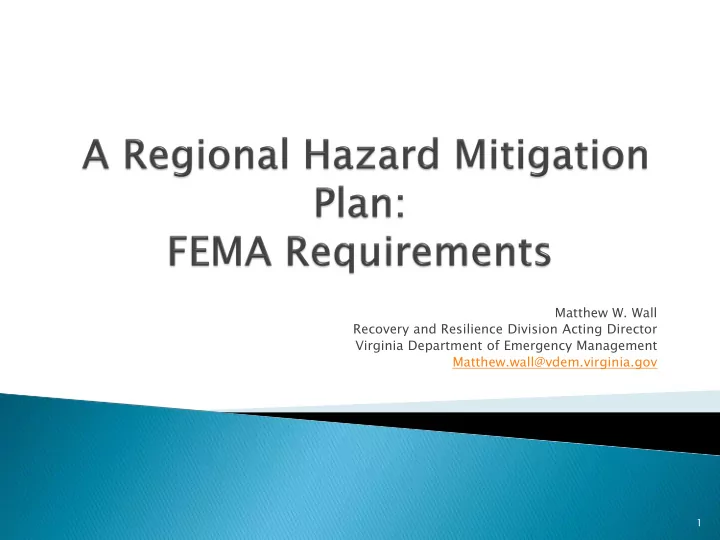

Matthew W. Wall Recovery and Resilience Division Acting Director Virginia Department of Emergency Management Matthew.wall@vdem.virginia.gov 1
Hazard mitigation is any sustained action taken to reduce or eliminate long-term risk to people and property from natural hazards and their effects. This definition distinguishes actions that have a long-term impact from those that are more closely associated with immediate preparedness, response, and recovery activities. Hazard mitigation is the only phase of emergency management specifically dedicated to breaking the cycle of damage, reconstruction, and repeated damage. 2
The mitigation planning requirements are authorized under the Robert T. Stafford Disaster Relief and Emergency Assistance Act (Stafford Act) (Public Law 93-288; 42 United States Code 5121 et seq.), as amended by: The Disaster Mitigation Act of 2000; National Flood Insurance Act of 1968, as amended [42 U.S.C. 4001 et seq.]; 44 CFR Part 201 Mitigation Planning; and 44 CFR Part 206, Subpart N Hazard Mitigation Grant Program, §206.434 Eligibility. 3
Identify Hazards which may impact the community §201.6(c (c)(2 )(2)( )(i): ): [The risk assessment sh shal all include a] description of the type … of all natural hazards that can affect the jurisdiction. §201.6(c (c)(2 )(2)( )(i): ): [The risk assessment sh shal all include a] description of the … location and extent of all natural hazards that can affect the jurisdiction. The plan sh shal all include information on previous occurrences of hazard events and on the probability of future hazard events . Analyze the Risks from identified hazards §201.6(c (c)(2 )(2)( )(ii): [The risk assessment sh shal all include a] description of the jurisdiction’s vulnerability to the hazards described in paragraph (c)(2)(i) of this section. This description sh shal all include an overall summary of each hazard and its impact on the community. 4
Develop implementable strategies to reduce the community’s risk from identified hazards §201. 01.6(c)( 6(c)(3)( 3)(i): ): [The hazard mitigation strategy shal all include a] description of mitigation goals to reduce or avoid long-term vulnerabilities to the identified hazards Identify methods, mechanisms, funding opportunities to implement the strategies Track the implementation and subsequent benefits 5
Provides for access to federal funding Hazard Mitigation Grant Program (HMGP), Flood Mitigation Assistance (FMA), and Pre-Disaster Mitigation (PDM) Public Assistance (PA), categories C – G: Roads, Bridges, Water Control Facilities, Buildings and Equipment, Utilities, Parks and other Wildfire Mitigation Grant Not having a current FEMA approved and locally adopted Hazard Mitigation Plan will result in the loss of access to these funding sources. Exceptions: When an event occurs and the locality has an existing expired plan in the process of being updated When an event occurs and the locality will have a new HP plan place prior to any funding being obligated Within a year of the event 6
Since 2010, the MPPDC region has been awarded mitigation projects grants totaling $11 11,568 568,275. 7
Be identified as a strategy in a current, federally approved and locally adopted HM plan Be technically feasible and effective Comply with floodplain management and protection of wetlands Pass an Environmental and Historical Preservation review Be Cost-Effective Benefit Cost Analysis Pass a “Cost Review” Costs are necessary, required, and reasonable 8
The 44 CFR has no reference There is a connective reference in guidance, specifically the “Local Mitigation Planning Handbook” updated January 2015 and located at: http://www.fema.gov/media-library- data/20130726-1910-25045- 9160/fema_local_mitigation_handbook.pdf page 5-8: “ Climate Change The planning team may decide to include a discussion of the impacts of climate change in the risk assessment. This is not required by Federal mitigation planning regulation, but can provide a better understanding of how risk may change in the future.” A regional Hazard Mitigation Plan can be formally adopted by a locality either inclusive of or excluding the language/information on Sea Level Rise. 9
Will be recognized by FEMA for the purpose of eligibility for: Public Assistance, categories C – G Hazard Mitigation Assistance grant programs Flood Mitigation Assistance Pre-Disaster Mitigation Hazard Mitigation Grant Program (post-disaster) Wildfire Mitigation Grants May have an impact on the Benefit Cost Analysis for flood mitigation structural projects 10
The plan meets all minimum requirements or it would not have been approved by FEMA Localities may adopt the plan either with or excluding the Sea Level Rise information No federal requirement to include it Confirmed by FEMA upon inquiry by VDEM Since the exclusion is allowed, there is no need to rewrite the plan Ado dopt ption of the he pl plan an wi with h or wi witho hout ut Sea a Le Level Ris l Rise la langu guage ge is is a lo loca cal l decis cisio ion. 11
Thank you 12
Recommend
More recommend